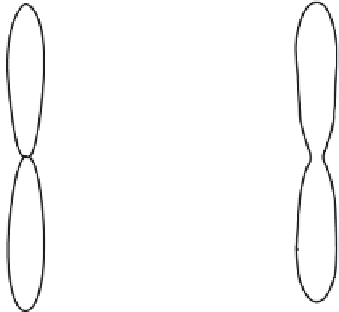Geoscience Reference
In-Depth Information
(a)
(b)
Fig. 2.39 Directional diagrams of energy emission for waves, caused by a bottom displacement
alternating in sign. The shape and orientation of the source (
a
1
=
a
2
= 5 (a),
a
1
= 7
,
a
2
= 3 (b))
are shown by the dotted line. Calculations are performed for
b
= 10,
τ
= 1 (thick line),
τ
= 10 (thin
line)
2
a
2
/
3, the physical meaning of which consists in it repre-
senting the potential energy of the initial elevation of the water, similar in shape
to the residual deformation of the ocean bottom. From Fig. 2.39 it is seen that in
thecaseofsymmetry(
a
1
=
a
2
= 5) no wave whatever is emitted in the 'fault' di-
rection (90
◦
and 270
◦
). This effect is evident from general arguments: perturbations
that happen to be identical in shape, but differ in their signs of bottom deformations,
cancel each other out along the symmetry axis. Such a symmetry is, naturally, quite
improbable in nature. Nevertheless, for the non-symmetric case (
a
1
= 7,
a
2
= 3),
also, the prevalent part of wave energy is emitted perpendicularly to the 'fault',
while the energy flux along the 'fault' direction is nearly 40 times smaller. An in-
crease of the duration of the bottom deformation reduces the energy of the generated
waves and weakens their directionality.
In conclusion, it must be stressed that the characteristics of tsunami waves may
depend essentially not only on the shape of the source and the space distribution
inside it of residual deformations of the ocean bottom, but also on how these defor-
mations developed in time.
gb
η
2
1
a
1
+
2
W
0
=
ρ
η
References
Abe K. (1978): A dislocation model of the 1933 Sanriku earthquake consistent with tsunami waves.
J. Phys. Earth. 26(4) 381-396
Basov B. I., Kaistrenko V. M., Levin B. W., et al. (1984): Some results of physical simulation of
tsunami wave excitation and propagation. In: Tsunami generation and wave runup on shore.
Radiosvyaz, Moscow (in Russian), pp. 68-72
Belokon' V. I., Goi A. A., Reznik B. L., Smal' N. A. (1986): Tsunami excitation by a seismic wave
packet subject to dispersion. Tsunami researches (in Russian), (1) 28-36 Moscow














